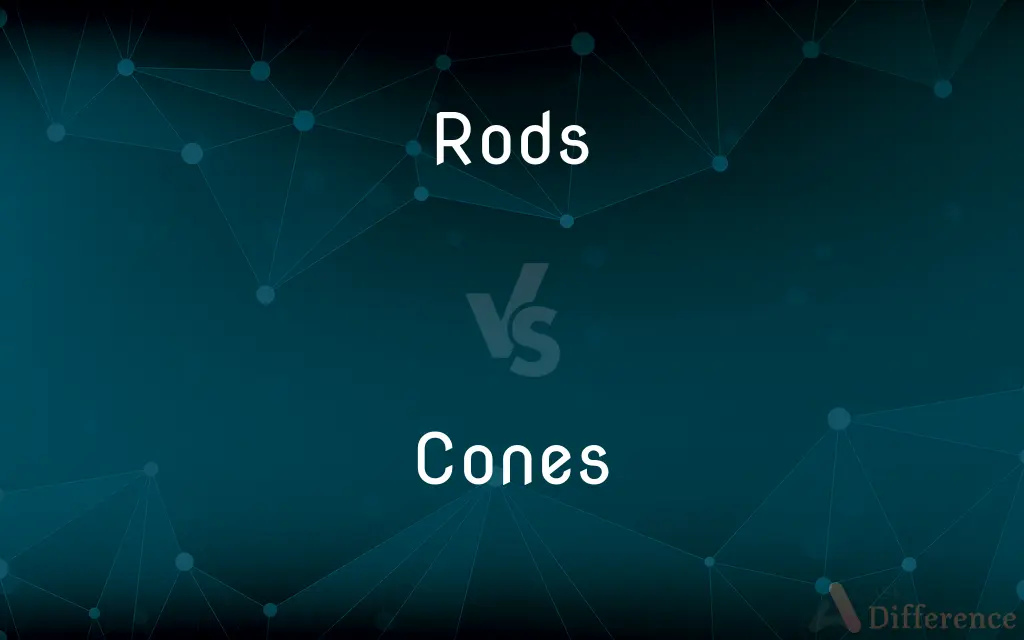Rods vs. Cones — What's the Difference?
Edited by Tayyaba Rehman — By Fiza Rafique — Published on October 25, 2023
Rods are photoreceptor cells in the retina that detect light and allow vision in low light, while Cones are responsible for color vision and work best in bright light.

Difference Between Rods and Cones
Table of Contents
ADVERTISEMENT
Key Differences
Rods and Cones play essential roles in how we perceive the world around us. Rods, found abundantly in the human retina, are specialized for night vision. They are most sensitive to light and dark changes, shapes, and movement and are not tuned to color differences. They provide peripheral vision - the side vision you have when you look straight ahead.
Contrarily, Cones are concentrated in the center of the retina, in an area called the fovea. Their primary function is to read colors, and they operate best in bright light. In essence, Cones allow for the detailed, color vision we experience during daylight. Each type of these photoreceptor cells is tuned to different light sensitivities and provides unique contributions to our visual experience. Simply put, without Rods, night-time vision would be nearly impossible; without Cones, our world would be void of vibrant colors.
Comparison Chart
Function
Detect light, enable low-light vision.
Responsible for color vision.
Light Sensitivity
High sensitivity, work well in low light.
Low sensitivity, require bright light.
Location in Retina
Distributed throughout the retina.
Concentrated in the fovea.
ADVERTISEMENT
Color Perception
Do not detect color.
Detect a range of colors.
Quantity in Eye
More abundant, about 120 million in the human eye.
Less abundant, about 6-7 million in the human eye.
Compare with Definitions
Rods
Have a longer, cylindrical shape compared to Cones.
The elongated structure of Rods contributes to their light-absorbing ability.
Cones
Photoreceptor cells responsible for color vision.
Cones let us appreciate the myriad hues in a rainbow.
Rods
Sensitive to brightness levels, not color differences.
In dim light, Rods help us discern shapes but not distinct colors.
Cones
Essential for detecting fine details in vision.
When reading, Cones help distinguish the intricacies of each letter.
Rods
Essential for peripheral and night vision.
When stargazing, Rods enable us to see the faint light of distant stars.
Cones
Primarily function in bright light situations.
In daylight, Cones are active, allowing for detailed color perception.
Rods
Outnumber Cones in the human retina.
The sheer number of Rods helps enhance our vision in poorly lit conditions.
Cones
Concentrated in the retina's fovea.
The fovea, rich in Cones, is the focal point for sharp, colored vision.
Rods
A fishing rod.
Cones
Classified into three types based on color sensitivity.
There are blue, green, and red Cones, each sensitive to its respective color spectrum.
Rods
A piston rod.
Cones
The surface generated by a straight line, the generator, passing through a fixed point, the vertex, and moving along a fixed curve, the directrix.
Rods
An often expandable horizontal bar, especially of metal, used to suspend household items such as curtains or towels.
Cones
A right circular cone.
Rods
A leveling rod.
Cones
The figure formed by a cone, bound or regarded as bound by its vertex and a plane section taken anywhere above or below the vertex.
Rods
A lightning rod.
Cones
Something having the shape of this figure
"the cone of illuminated drops spilling beneath a street lamp" (Anne Tyler).
Rods
A divining rod.
Cones
A unisexual reproductive structure of most gymnospermous plants, such as conifers and cycads, typically consisting of a central axis around which there are scaly, overlapping, spirally arranged sporophylls that bear either pollen-containing structures or ovules.
Rods
A measuring stick.
Cones
A similar, spore-producing structure of club mosses, horsetails, and spikemosses.
Rods
One of the horizontal elements in a truss system underneath a rail car, especially a freight car.
Cones
A reproductive structure resembling a cone, such as the female inflorescence of a hop plant or the woody female catkin of an alder.
Rods
A shoot or stem cut from or growing as part of a woody plant.
Cones
(Physiology) One of the photoreceptors in the retina of the eye that is responsible for daylight and color vision. These photoreceptors are most densely concentrated in the fovea centralis, creating the area of greatest visual acuity. Also called cone cell.
Rods
A stick or bundle of sticks or switches used to give punishment by whipping.
Cones
Any of various gastropod mollusks of the family Conidae of tropical and subtropical seas that have a conical, often vividly marked shell and that inject their prey with poisonous toxins, which can be fatal to humans. Also called cone shell.
Rods
Punishment; correction.
Cones
To shape (something) like a cone or a segment of one.
Rods
A scepter, staff, or wand symbolizing power or authority.
Cones
Plural of cone
Rods
Power or dominion, especially of a tyrannical nature
"under the rod of a cruel slavery" (John Henry Newman).
Cones
Infl of cone
Rods
A linear measure equal to 5.5 yards or 16.5 feet (5.03 meters). Also called pole2.
Rods
The square of this measure, equal to 30.25 square yards or 272.25 square feet (25.30 square meters).
Rods
(Anatomy) Any of various rod-shaped cells in the retina that respond to dim light. Also called rod cell.
Rods
(Microbiology) An elongated bacterium; a bacillus.
Rods
(Slang) A pistol or revolver.
Rods
Vulgar Slang A penis, especially when erect.
Rods
Plural of rod
Rods
Photoreceptor cells aiding in low-light vision.
Thanks to Rods, we can navigate our homes with the lights off.
Common Curiosities
Why are Rods important for night vision?
Rods have high sensitivity to light, making them ideal for low-light conditions.
Why do things appear grayscale in the dark?
Rods, active in low light, don't detect color, leading to monochromatic perception.
Are there areas of the retina without Rods or Cones?
Yes, the optic nerve's exit point lacks both, creating a "blind spot."
Why is the center of our vision so detailed?
The fovea in the retina's center is packed with Cones, enabling sharp, detailed vision.
How do Cones allow us to see colors?
Cones are sensitive to different parts of the light spectrum, letting us perceive colors.
Can Cones function in the dark?
Cones require bright light to function effectively and are not well-suited for darkness.
Can we detect motion better in low light?
Yes, Rods, abundant in the retina's periphery and active in dim light, are sensitive to motion.
Are there diseases affecting Rods and Cones?
Yes, conditions like retinitis pigmentosa affect Rods, while macular degeneration affects Cones.
Which photoreceptor is responsible for detailed vision?
Cones are responsible for detailed and color vision, especially in bright light.
Do all animals have the same number of Rods and Cones?
No, the ratio varies. Nocturnal animals, for example, have more Rods for better night vision.
Are colorblindness and night blindness related to Rods and Cones?
Yes, colorblindness is often due to Cone issues, while night blindness relates to Rod dysfunction.
How do our eyes adjust when we move from a bright to a dark room?
The Rods and Cones adjust their sensitivity, a process called dark adaptation.
Which are more numerous, Rods or Cones?
Rods are more numerous, with about 120 million in the human retina, compared to 6-7 million Cones.
Can we distinguish colors in our peripheral vision?
Peripheral vision primarily relies on Rods, so color perception is less accurate there.
Why is our nighttime vision less detailed than daytime?
Night vision relies on Rods, which don't provide the detailed, colored vision that Cones do.
Share Your Discovery

Previous Comparison
Prokaryotic Ribosomes vs. Eukaryotic Ribosomes
Next Comparison
Calcium Chloride vs. Magnesium ChlorideAuthor Spotlight
Written by
Fiza RafiqueFiza Rafique is a skilled content writer at AskDifference.com, where she meticulously refines and enhances written pieces. Drawing from her vast editorial expertise, Fiza ensures clarity, accuracy, and precision in every article. Passionate about language, she continually seeks to elevate the quality of content for readers worldwide.
Edited by
Tayyaba RehmanTayyaba Rehman is a distinguished writer, currently serving as a primary contributor to askdifference.com. As a researcher in semantics and etymology, Tayyaba's passion for the complexity of languages and their distinctions has found a perfect home on the platform. Tayyaba delves into the intricacies of language, distinguishing between commonly confused words and phrases, thereby providing clarity for readers worldwide.















































